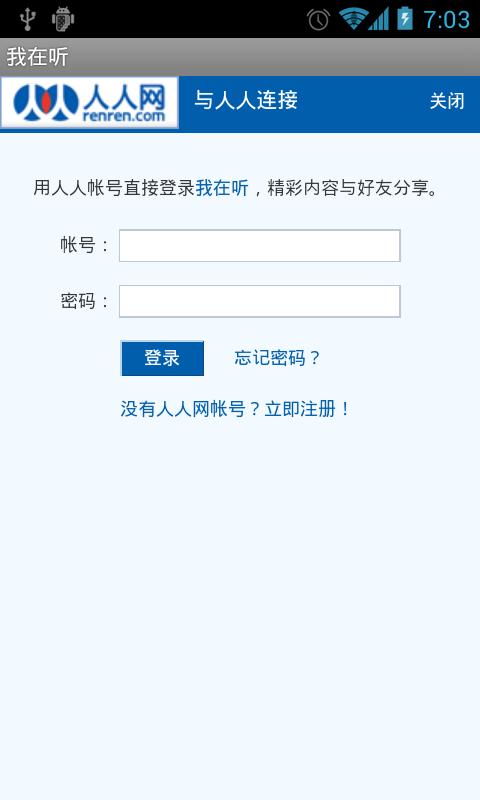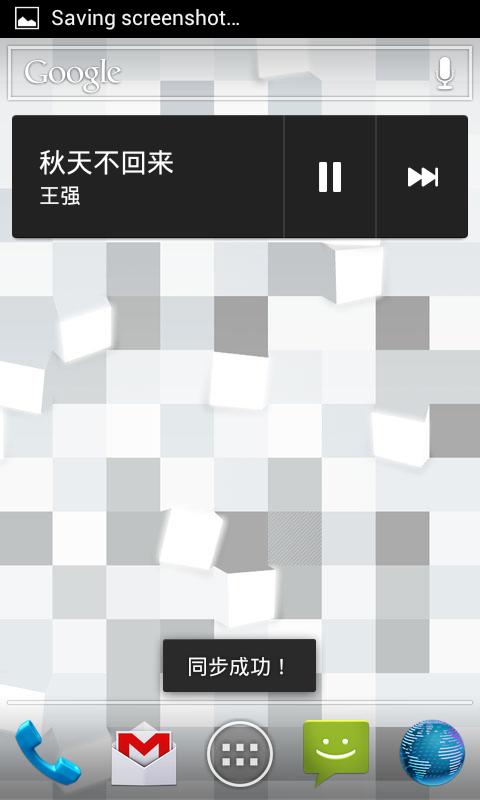Android与人人网连接实例:我在听
2012-05-02 09:50
330 查看
作者:裘德超
目前,社交网络概念正火。而手机最初设计的目的正是让人们进行通信。人人网作为中国最大的社交网站,用户数量众多,本文通过一个简单的小程序:“我在听”向大家展示renren api的使用。
首先介绍一下“我在听”。功能:在用户听歌时,在不需要用户进行额外操作的情况下,根据用户正在听的曲目,以发状态的形式同步至人人网。在安装完“我在听”之后,点击使用人人网登录,输入账号密码,登录成功后,选择是否自动同步,如果此时用户打开了网络,那么只要用户通过自带的播放器听歌,就会自动发布状态,例如:我在听张国荣的《倩女幽魂》。
下面开始介绍开发过程;
首先,在人人 api页面http://dev.renren.com/ 里先登录,然后创建一个android应用。填写完表单,创建完成后,可以获得人人给你的唯一标志:
应用ID:xxxxxxx
API Key:xxxxxxxxxxxxxxxxxxxxxxx
Secret Key:xxxxxxxxxxxxxxxxxxxxxx
这三串字符串用于标志你的应用。
下面介绍如何获取用户当前正在听的歌的信息:
当系统默认的播放器开始播放下一首歌时,会发出一个广播(intent中包含歌曲名,艺术家等信息),我们只要定义一个接收这个广播的广播接收器,并且从intent中抽取出需要的信息即可。
AndroidManifest.xml
根据main.xml可知,我们定义了类MusicBroadcastReceiver捕捉action名为com.android.music.metachanged的广播。
src/com/renoqiu/ MusicBroadcastReceiver.java
package com.renoqiu;
import android.content.BroadcastReceiver;
import android.content.Context;
import android.content.Intent;
import android.os.Bundle;
public class MusicBroadcastReceiver extends BroadcastReceiver {
private static final Object SMSRECEIVED = "com.android.music.metachanged";
@Override
public void onReceive(Context context, Intent intent) {
if(intent.getAction().equals(SMSRECEIVED)){
String trackName=intent.getStringExtra("track");
String artist=intent.getStringExtra("artist");
Intent pushStatusIntent = new Intent();
pushStatusIntent.setAction("com.renoqiu.pushstatus");
Bundle myBundle = new Bundle();
myBundle.putString("trackName", trackName);
myBundle.putString("artist", artist);
pushStatusIntent.putExtras(myBundle);
context.startService(pushStatusIntent);
}
}
}
在类MusicBroadcastReceiver中我们抽取了歌曲名和艺术家名,并且调用context.startService()方法创建了一个service。
src/com/renoqiu/ PushStatusService.java
package com.renoqiu;
import android.app.Service;
import android.content.Context;
import android.content.Intent;
import android.content.SharedPreferences;
import android.net.ConnectivityManager;
import android.net.NetworkInfo;
import android.os.Bundle;
import android.os.Handler;
import android.os.IBinder;
import android.os.Message;
import android.widget.Toast;
public class PushStatusService extends Service {
private Handler handler;
private com.renoqiu.LooperThread thread;
private SharedPreferences sharedPreferences;
private boolean syncFlag;
private ConnectivityManager cm;
private NetworkInfo ni;
@Override
public IBinder onBind(Intent arg0) {
return null;
}
private boolean checkNet() {
cm = (ConnectivityManager)getSystemService(Context.CONNECTIVITY_SERVICE);
if (cm == null) {
return false;
}
ni = cm.getActiveNetworkInfo();
if (ni == null || !ni.isAvailable()) {
return false;
}
return true;
}
@Override
public void onStart(Intent intent, int startId) {
super.onStart(intent, startId);
syncFlag = sharedPreferences.getBoolean("syncFlag",false);
if(syncFlag && checkNet()){
if(intent != null){
Bundle myBundle = intent.getExtras();
String trackName = myBundle.getString("trackName");
String artist = myBundle.getString("artist");
String accessToken = sharedPreferences.getString("accessToken","");
if(accessToken != null && !accessToken.equals("")){
String requestMethod = "status.set";
//接口名称
String url = StatusPublishHelper.API_URL;
String secretKey = StatusPublishHelper.SECRET_KEY;
if(artist == null || artist.equals("")){
artist = "xxx";
}
if(trackName == null || trackName.equals("")){
trackName = "xxx";
}
String message = "我在听" + artist + "的《" + trackName + "》。\r\n 通过我在听发布!";
thread = new LooperThread(handler, requestMethod, "1.0", url, accessToken, message, secretKey);
thread.start(); /* 启动线程 */
}else{
Toast.makeText(PushStatusService.this, "请登陆!", Toast.LENGTH_SHORT).show();
SharedPreferences.Editor editor = sharedPreferences.edit();
editor.putBoolean("syncFlag", false);
editor.commit();
}
}
}
}
@Override
public void onCreate() {
super.onCreate();
sharedPreferences = getSharedPreferences("shared", MODE_PRIVATE);
handler = new Handler() {
@Override
public void handleMessage(Message msg) {
switch (msg.what) {
case 0:
if((Integer)msg.obj != 1){
Toast.makeText(PushStatusService.this, "同步失败!请检查网络是否打开...", Toast.LENGTH_SHORT).show();
}else{
Toast.makeText(PushStatusService.this, "同步成功!", Toast.LENGTH_SHORT).show();
}
break;
}
}
};
}
}
在PushStatusService中,首先进行一系列检查,例如:网络是否已经打开,用户是否已经登录,是否开启同步等信息。其中用到了sharedPreferences保存信息。如果条件都满足那么将新建一个线程去通过人人api发状态,其中就需要使用到之前创建应用时所得到的key,在介绍具体如何状态之前先接着介绍一下人人的api。要通过人人发送状态首先必须通过人人的登录认证:OAuth2.0,详情见:http://wiki.dev.renren.com/wiki/Authentication
我们的登录流程开始于通过内嵌在IamListenActivity中的Webkit访问人人OAuth 2.0的Authorize Endpoint:
https://graph.renren.com/oauth/authorize?client_id=YOUR_API_KEY&response_type=token&redirect_uri=YOUR_CALLBACK_URL&display=touch&scope=status_update。
client_id:必须参数。在开发者中心注册应用时获得的API Key。
response_type:必须参数。客户端流程,此值固定为“token”。当用户登录成功,浏览器会被重定向到YOUR_CALLBACK_URL,并且带有参数Access Token。这个Access Token可以标志登录用户,避免需要多次输入用户名密码。此处我们会把accesstoken保存在sharedPreferences中,下次需要使用时,直接从sharedPreferences中获取。
redirect_uri:登录成功,流程结束后要跳转回得URL。redirect_uri所在的域名必须在开发者中心注册应用后,填写在编辑属性选项卡中填写到服务器域名中,人人OAuth2.0用以检查跳转的合法性。
如果用户已经登录,人人OAuth 2.0会校验存储在用户浏览器中的Cookie。如果用户没有登录,人人OAuth 2.0会为用户展示登录页面,让用户输入用户名和密码:
display=touch:一般的智能手机都是这个选项,
scope=status_update:表示我们会用到更新状态的功能。
src/com/renoqiu/ IamListenActivity.java
package com.renoqiu;
import java.net.URLDecoder;
import android.app.Activity;
import android.content.SharedPreferences;
import android.os.Bundle;
import android.webkit.WebSettings;
import android.webkit.WebView;
import android.webkit.WebViewClient;
import android.widget.Toast;
public class IamListenActivity extends Activity {
private WebView webView;
private String accessToken = null;
public void onCreate(Bundle savedInstanceState) {
super.onCreate(savedInstanceState);
setContentView(R.layout.main);
webView = (WebView) findViewById(R.id.web);
WebSettings settings = webView.getSettings();
settings.setJavaScriptEnabled(true);
settings.setSupportZoom(true);
settings.setBuiltInZoomControls(true);
webView.loadUrl(StatusPublishHelper.AUTHURL);
webView.requestFocusFromTouch();
WebViewClient wvc = new WebViewClient() {
@Override
public void onPageFinished(WebView view, String url) {
super.onPageFinished(view, url);
//人人网用户名和密码验证通过后,刷新页面时即可返回accessToken
String reUrl = webView.getUrl();
if (reUrl != null && reUrl.indexOf("access_token") != -1) {
//截取url中的accessToken
int startPos = reUrl.indexOf("token=") + 6;
int endPos = reUrl.indexOf("&expires_in");
accessToken = URLDecoder.decode(reUrl.substring(startPos, endPos));
//保存获取到的accessToken
//share.saveRenrenToken(accessToken);
Toast.makeText(IamListenActivity.this, "验证成功,设置同步后。\n听歌时就能自动传状态哦。:)", Toast.LENGTH_SHORT).show();
SharedPreferences settings = (SharedPreferences)getSharedPreferences("shared", MODE_PRIVATE);
SharedPreferences.Editor editor = settings.edit();
editor.putString("accessToken", accessToken);
editor.putBoolean("syncFlag", false);
editor.commit();
finish();
}
}
};
webView.setWebViewClient(wvc);
}
}
res/layout/main.xml
<?xml version="1.0" encoding="utf-8"?>
<LinearLayout xmlns:android="http://schemas.android.com/apk/res/android"
android:layout_width="fill_parent"
android:layout_height="fill_parent"
android:orientation="vertical" >
<WebView
android:id="@+id/web"
android:layout_width="match_parent"
android:layout_height="match_parent" />
</LinearLayout>
由代码可知,我们通过webkit访问Authorize Endpoint后,从返回的链接中抽取了accesstoken,并且保存起来了。有了access token之后,我们就可以通过renren的api,进行更新状态的操作了,下面的LooperThread就是用于更新状态,并且给出用户反馈的类。
“为了确保应用与人人API 服务器之间的安全通信,防止Secret Key盗用,数据篡改等恶意攻击,人人API服务器使用了签名机制(即sig参数)来认证应用。签名是由请求参数和应用的私钥Secret Key经过MD5加密后生成的字符串。应用在调用人人API之前,要计算出签名,并追加到请求参数中。“(关于签名的计算规则参见:http://wiki.dev.renren.com/wiki/Calculate_signature)
src/com/renoqiu/ LooperThread.java
上面代码中,首先计算出所有参数以字典序升序排列后,拼接在一起后的md5值作为签名。然后向http://api.renren.com/restserver.do发送post请求,其中包括之前获得的access_token,所调用的方法名(此处我们调用的是更新状态的方法名,关于各种api详见:http://wiki.dev.renren.com/wiki/API),及方法的参数,此处包括版本,状态内容,返回类型(此处为json),最后是签名。
params.add(newBasicNameValuePair("access_token", accessToken));
params.add(newBasicNameValuePair("method", requestMethod));
params.add(newBasicNameValuePair("v", v));
params.add(newBasicNameValuePair("status", status));
params.add(newBasicNameValuePair("format", "JSON"));
params.add(newBasicNameValuePair("sig", sig));
然后等待服务器的回复,并且解析json格式的数据,判断是否发送成功。
到此,基本的发状态的过程就结束了。
下面的类用于提供用户登陆以及让用户选择是否开启自动同步。
src/com/renoqiu/ SettingActivity.java
package com.renoqiu;
import android.app.Activity;
import android.content.Intent;
import android.content.SharedPreferences;
import android.os.Bundle;
import android.view.View;
import android.view.View.OnClickListener;
import android.widget.Button;
import android.widget.CompoundButton;
import android.widget.Toast;
import android.widget.CompoundButton.OnCheckedChangeListener;
import android.widget.ToggleButton;
public class SettingActivity extends Activity {
private ToggleButton syncToggleButton;
private Button loginBtn;
private SharedPreferences sharedPreferences;
@Override
protected void onCreate(Bundle savedInstanceState) {
super.onCreate(savedInstanceState);
setContentView(R.layout.setting);
syncToggleButton = (ToggleButton)findViewById(R.id.syncToggleButton);
sharedPreferences = (SharedPreferences)getSharedPreferences("shared", MODE_PRIVATE);
boolean syncFlag = sharedPreferences.getBoolean("syncFlag",false);
syncToggleButton.setChecked(syncFlag);
syncToggleButton.setOnCheckedChangeListener(new OnCheckedChangeListener(){
@Override
public void onCheckedChanged(CompoundButton buttonView,
boolean isChecked) {
if(isChecked == false){
SharedPreferences.Editor editor = sharedPreferences.edit();
editor.putBoolean("syncFlag", isChecked);
editor.commit();
}else{
String accessToken = sharedPreferences.getString("accessToken","");
if(accessToken != null && !accessToken.equals("") ){
SharedPreferences.Editor editor = sharedPreferences.edit();
editor.putBoolean("syncFlag", isChecked);
editor.commit();
}else{
syncToggleButton.setChecked(false);
Toast.makeText(SettingActivity.this, "请先登陆!", Toast.LENGTH_SHORT).show();
}
}
}
});
loginBtn = (Button)findViewById(R.id.loginBtn);
loginBtn.setOnClickListener(new OnClickListener(){
@Override
public void onClick(View arg0) {
Intent intent = new Intent(SettingActivity.this, IamListenActivity.class);
startActivity(intent);
}});
}
}
res/layout/setting.xml
<?xml version="1.0" encoding="utf-8"?>
<LinearLayout xmlns:android="http://schemas.android.com/apk/res/android"
android:layout_width="fill_parent"
android:layout_height="fill_parent"
android:orientation="vertical" >
<Button
android:id="@+id/loginBtn"
android:layout_width="wrap_content"
android:layout_height="wrap_content"
android:text=""
android:background="@drawable/btn_login"
android:layout_marginTop="10dp"/>
<RelativeLayout
android:id="@+id/relativeLayout1"
android:layout_width="match_parent"
android:layout_height="wrap_content" >
<TextView
android:id="@+id/toggleTextView"
android:layout_width="wrap_content"
android:layout_height="wrap_content"
android:layout_alignParentLeft="true"
android:layout_alignParentTop="true"
android:layout_marginTop="20dp"
android:text="@string/toggleSync" />
<ToggleButton
android:id="@+id/syncToggleButton"
android:layout_width="wrap_content"
android:layout_height="wrap_content"
android:layout_alignParentTop="true"
android:layout_marginTop="10dp"
android:layout_marginLeft="10dp"
android:layout_toRightOf="@+id/toggleTextView" />
</RelativeLayout>
</LinearLayout>
最后一个类包含了各种链接常量,和把字符串转换为md5的方法:
src/com/renoqiu/ StatusPublishHelper.java
package com.renoqiu;
import java.security.MessageDigest;
public class StatusPublishHelper {
// 你的应用ID
public static final String APP_ID = "xxxxx";
// 应用的API Key
public static final String API_KEY = "xxxxxxxxxxxxxxxxxxxxxxx";
// 应用的Secret Key
public static final String SECRET_KEY = "xxxxxxxxxxxxxxxx";
public static final String API_URL = "http://api.renren.com/restserver.do";
public static final String AUTHURL = "https://graph.renren.com/oauth/authorize?client_id="
+ API_KEY +"&response_type=token"
+ "&redirect_uri=http://www.renoqiu.com/iamlisten.html&display=touch"
+ "&scope=status_update";
public static String getMD5(String s) {
try {
MessageDigest md5 = MessageDigest.getInstance("MD5");
byte[] byteArray = s.getBytes("UTF-8");
byte[] md5Bytes = md5.digest(byteArray);
StringBuffer hexValue = new StringBuffer();
for (int i = 0; i < md5Bytes.length; i++) {
int val = ((int) md5Bytes[i]) & 0xff;
if (val < 16)
hexValue.append("0");
hexValue.append(Integer.toHexString(val));
}
return hexValue.toString();
} catch (Exception e) {
e.printStackTrace();
return null;
}
}
}
下图为测试使用的效果。



SourceCode下载链接:
https://github.com/renoqiu/IamListening
需要注意的是:下载的源代码并不能直接使用,读者需要自行修改IamListening/src/com/renoqiu/StatusPublishHelper.java类下的APP_ID, API_KEY, SECRET_KEY 这三个常量为你申请的应用的对应的值后,就可以正常使用了。
http://code.google.com/p/iamlisten/downloads/list可以从这里现在一个笔者编译好的apk文件,进行测试。
参考链接:
http://wiki.dev.renren.com/wiki/API
http://wiki.dev.renren.com/wiki/Calculate_signature
http://wiki.dev.renren.com/wiki/Authentication
目前,社交网络概念正火。而手机最初设计的目的正是让人们进行通信。人人网作为中国最大的社交网站,用户数量众多,本文通过一个简单的小程序:“我在听”向大家展示renren api的使用。
首先介绍一下“我在听”。功能:在用户听歌时,在不需要用户进行额外操作的情况下,根据用户正在听的曲目,以发状态的形式同步至人人网。在安装完“我在听”之后,点击使用人人网登录,输入账号密码,登录成功后,选择是否自动同步,如果此时用户打开了网络,那么只要用户通过自带的播放器听歌,就会自动发布状态,例如:我在听张国荣的《倩女幽魂》。
下面开始介绍开发过程;
首先,在人人 api页面http://dev.renren.com/ 里先登录,然后创建一个android应用。填写完表单,创建完成后,可以获得人人给你的唯一标志:
应用ID:xxxxxxx
API Key:xxxxxxxxxxxxxxxxxxxxxxx
Secret Key:xxxxxxxxxxxxxxxxxxxxxx
这三串字符串用于标志你的应用。
下面介绍如何获取用户当前正在听的歌的信息:
当系统默认的播放器开始播放下一首歌时,会发出一个广播(intent中包含歌曲名,艺术家等信息),我们只要定义一个接收这个广播的广播接收器,并且从intent中抽取出需要的信息即可。
AndroidManifest.xml
<?xml version="1.0" encoding="utf-8"?> <manifest xmlns:android="http://schemas.android.com/apk/res/android" package="com.renoqiu" android:versionCode="1" android:versionName="1.0" > <uses-sdk android:minSdkVersion="10" /> <uses-permission android:name="android.permission.INTERNET" /> <uses-permission android:name="android.permission.ACCESS_NETWORK_STATE"/> <application android:icon="@drawable/ic_launcher" android:label="@string/app_name" > <activity android:name=".IamListenActivity" android:label="@string/app_name" > </activity> <activity android:name=".SettingActivity" android:label="@string/app_name" > <intent-filter> <action android:name="android.intent.action.MAIN" /> <category android:name="android.intent.category.LAUNCHER" /> </intent-filter> </activity> <receiver android:name=".MusicBroadcastReceiver"> <intent-filter> <action android:name="com.android.music.metachanged"></action> </intent-filter> </receiver> <service android:name=".PushStatusService" > <intent-filter> <action android:name="com.renoqiu.pushstatus" /> </intent-filter> </service> </application> </manifest>
根据main.xml可知,我们定义了类MusicBroadcastReceiver捕捉action名为com.android.music.metachanged的广播。
src/com/renoqiu/ MusicBroadcastReceiver.java
package com.renoqiu;
import android.content.BroadcastReceiver;
import android.content.Context;
import android.content.Intent;
import android.os.Bundle;
public class MusicBroadcastReceiver extends BroadcastReceiver {
private static final Object SMSRECEIVED = "com.android.music.metachanged";
@Override
public void onReceive(Context context, Intent intent) {
if(intent.getAction().equals(SMSRECEIVED)){
String trackName=intent.getStringExtra("track");
String artist=intent.getStringExtra("artist");
Intent pushStatusIntent = new Intent();
pushStatusIntent.setAction("com.renoqiu.pushstatus");
Bundle myBundle = new Bundle();
myBundle.putString("trackName", trackName);
myBundle.putString("artist", artist);
pushStatusIntent.putExtras(myBundle);
context.startService(pushStatusIntent);
}
}
}
在类MusicBroadcastReceiver中我们抽取了歌曲名和艺术家名,并且调用context.startService()方法创建了一个service。
src/com/renoqiu/ PushStatusService.java
package com.renoqiu;
import android.app.Service;
import android.content.Context;
import android.content.Intent;
import android.content.SharedPreferences;
import android.net.ConnectivityManager;
import android.net.NetworkInfo;
import android.os.Bundle;
import android.os.Handler;
import android.os.IBinder;
import android.os.Message;
import android.widget.Toast;
public class PushStatusService extends Service {
private Handler handler;
private com.renoqiu.LooperThread thread;
private SharedPreferences sharedPreferences;
private boolean syncFlag;
private ConnectivityManager cm;
private NetworkInfo ni;
@Override
public IBinder onBind(Intent arg0) {
return null;
}
private boolean checkNet() {
cm = (ConnectivityManager)getSystemService(Context.CONNECTIVITY_SERVICE);
if (cm == null) {
return false;
}
ni = cm.getActiveNetworkInfo();
if (ni == null || !ni.isAvailable()) {
return false;
}
return true;
}
@Override
public void onStart(Intent intent, int startId) {
super.onStart(intent, startId);
syncFlag = sharedPreferences.getBoolean("syncFlag",false);
if(syncFlag && checkNet()){
if(intent != null){
Bundle myBundle = intent.getExtras();
String trackName = myBundle.getString("trackName");
String artist = myBundle.getString("artist");
String accessToken = sharedPreferences.getString("accessToken","");
if(accessToken != null && !accessToken.equals("")){
String requestMethod = "status.set";
//接口名称
String url = StatusPublishHelper.API_URL;
String secretKey = StatusPublishHelper.SECRET_KEY;
if(artist == null || artist.equals("")){
artist = "xxx";
}
if(trackName == null || trackName.equals("")){
trackName = "xxx";
}
String message = "我在听" + artist + "的《" + trackName + "》。\r\n 通过我在听发布!";
thread = new LooperThread(handler, requestMethod, "1.0", url, accessToken, message, secretKey);
thread.start(); /* 启动线程 */
}else{
Toast.makeText(PushStatusService.this, "请登陆!", Toast.LENGTH_SHORT).show();
SharedPreferences.Editor editor = sharedPreferences.edit();
editor.putBoolean("syncFlag", false);
editor.commit();
}
}
}
}
@Override
public void onCreate() {
super.onCreate();
sharedPreferences = getSharedPreferences("shared", MODE_PRIVATE);
handler = new Handler() {
@Override
public void handleMessage(Message msg) {
switch (msg.what) {
case 0:
if((Integer)msg.obj != 1){
Toast.makeText(PushStatusService.this, "同步失败!请检查网络是否打开...", Toast.LENGTH_SHORT).show();
}else{
Toast.makeText(PushStatusService.this, "同步成功!", Toast.LENGTH_SHORT).show();
}
break;
}
}
};
}
}
在PushStatusService中,首先进行一系列检查,例如:网络是否已经打开,用户是否已经登录,是否开启同步等信息。其中用到了sharedPreferences保存信息。如果条件都满足那么将新建一个线程去通过人人api发状态,其中就需要使用到之前创建应用时所得到的key,在介绍具体如何状态之前先接着介绍一下人人的api。要通过人人发送状态首先必须通过人人的登录认证:OAuth2.0,详情见:http://wiki.dev.renren.com/wiki/Authentication
我们的登录流程开始于通过内嵌在IamListenActivity中的Webkit访问人人OAuth 2.0的Authorize Endpoint:
https://graph.renren.com/oauth/authorize?client_id=YOUR_API_KEY&response_type=token&redirect_uri=YOUR_CALLBACK_URL&display=touch&scope=status_update。
client_id:必须参数。在开发者中心注册应用时获得的API Key。
response_type:必须参数。客户端流程,此值固定为“token”。当用户登录成功,浏览器会被重定向到YOUR_CALLBACK_URL,并且带有参数Access Token。这个Access Token可以标志登录用户,避免需要多次输入用户名密码。此处我们会把accesstoken保存在sharedPreferences中,下次需要使用时,直接从sharedPreferences中获取。
redirect_uri:登录成功,流程结束后要跳转回得URL。redirect_uri所在的域名必须在开发者中心注册应用后,填写在编辑属性选项卡中填写到服务器域名中,人人OAuth2.0用以检查跳转的合法性。
如果用户已经登录,人人OAuth 2.0会校验存储在用户浏览器中的Cookie。如果用户没有登录,人人OAuth 2.0会为用户展示登录页面,让用户输入用户名和密码:
display=touch:一般的智能手机都是这个选项,
scope=status_update:表示我们会用到更新状态的功能。
src/com/renoqiu/ IamListenActivity.java
package com.renoqiu;
import java.net.URLDecoder;
import android.app.Activity;
import android.content.SharedPreferences;
import android.os.Bundle;
import android.webkit.WebSettings;
import android.webkit.WebView;
import android.webkit.WebViewClient;
import android.widget.Toast;
public class IamListenActivity extends Activity {
private WebView webView;
private String accessToken = null;
public void onCreate(Bundle savedInstanceState) {
super.onCreate(savedInstanceState);
setContentView(R.layout.main);
webView = (WebView) findViewById(R.id.web);
WebSettings settings = webView.getSettings();
settings.setJavaScriptEnabled(true);
settings.setSupportZoom(true);
settings.setBuiltInZoomControls(true);
webView.loadUrl(StatusPublishHelper.AUTHURL);
webView.requestFocusFromTouch();
WebViewClient wvc = new WebViewClient() {
@Override
public void onPageFinished(WebView view, String url) {
super.onPageFinished(view, url);
//人人网用户名和密码验证通过后,刷新页面时即可返回accessToken
String reUrl = webView.getUrl();
if (reUrl != null && reUrl.indexOf("access_token") != -1) {
//截取url中的accessToken
int startPos = reUrl.indexOf("token=") + 6;
int endPos = reUrl.indexOf("&expires_in");
accessToken = URLDecoder.decode(reUrl.substring(startPos, endPos));
//保存获取到的accessToken
//share.saveRenrenToken(accessToken);
Toast.makeText(IamListenActivity.this, "验证成功,设置同步后。\n听歌时就能自动传状态哦。:)", Toast.LENGTH_SHORT).show();
SharedPreferences settings = (SharedPreferences)getSharedPreferences("shared", MODE_PRIVATE);
SharedPreferences.Editor editor = settings.edit();
editor.putString("accessToken", accessToken);
editor.putBoolean("syncFlag", false);
editor.commit();
finish();
}
}
};
webView.setWebViewClient(wvc);
}
}
res/layout/main.xml
<?xml version="1.0" encoding="utf-8"?>
<LinearLayout xmlns:android="http://schemas.android.com/apk/res/android"
android:layout_width="fill_parent"
android:layout_height="fill_parent"
android:orientation="vertical" >
<WebView
android:id="@+id/web"
android:layout_width="match_parent"
android:layout_height="match_parent" />
</LinearLayout>
由代码可知,我们通过webkit访问Authorize Endpoint后,从返回的链接中抽取了accesstoken,并且保存起来了。有了access token之后,我们就可以通过renren的api,进行更新状态的操作了,下面的LooperThread就是用于更新状态,并且给出用户反馈的类。
“为了确保应用与人人API 服务器之间的安全通信,防止Secret Key盗用,数据篡改等恶意攻击,人人API服务器使用了签名机制(即sig参数)来认证应用。签名是由请求参数和应用的私钥Secret Key经过MD5加密后生成的字符串。应用在调用人人API之前,要计算出签名,并追加到请求参数中。“(关于签名的计算规则参见:http://wiki.dev.renren.com/wiki/Calculate_signature)
src/com/renoqiu/ LooperThread.java
package com.renoqiu;
import java.util.ArrayList;
import java.util.List;
import org.apache.http.HttpResponse;
import org.apache.http.NameValuePair;
import org.apache.http.client.entity.UrlEncodedFormEntity;
import org.apache.http.client.methods.HttpPost;
import org.apache.http.impl.client.DefaultHttpClient;
import org.apache.http.message.BasicNameValuePair;
import org.apache.http.protocol.HTTP;
import org.apache.http.util.EntityUtils;
import org.json.JSONObject;
import android.os.Handler;
import android.os.Message;
import android.util.Log;
public class LooperThread extends Thread{
private String requestMethod;
private String v;
private String url;
private String accessToken;
private String status;
private String secretKey;
private Handler fatherHandler;
public LooperThread(Handler fatherHandler, String requestMethod, String v, String url, String accessToken, String message, String secretKey) {
this.requestMethod = requestMethod;
this.v = v;
this.url = url;
this.accessToken = accessToken;
this.status = message;
this.secretKey = secretKey;
this.fatherHandler = fatherHandler;
}
public void run() {
Message msg = new Message();
msg.obj = updateStatus(status);
msg.what = 0;
fatherHandler.sendMessage(msg);
}
public int updateStatus(String status) {
int success = 0;
//生成签名 字典序排列
StringBuilder sb = new StringBuilder();
sb.append("access_token=").append(accessToken)
.append("format=").append("JSON")
.append("method=").append(requestMethod)
.append("status=").append(status)
.append("v=").append(v)
.append(secretKey);
String sig = StatusPublishHelper.getMD5(sb.toString());
HttpPost httpRequest = new HttpPost(url);
List<NameValuePair> params = new ArrayList<NameValuePair>();
params.add(new BasicNameValuePair("access_token", accessToken));
params.add(new BasicNameValuePair("method", requestMethod));
params.add(new BasicNameValuePair("v", v));
params.add(new BasicNameValuePair("status", status));
params.add(new BasicNameValuePair("format", "JSON"));
params.add(new BasicNameValuePair("sig", sig));
try {
httpRequest.setEntity(new UrlEncodedFormEntity(params, HTTP.UTF_8));
HttpResponse httpResponse = new DefaultHttpClient().execute(httpRequest);
if (httpResponse.getStatusLine().getStatusCode() == 200){
String result = EntityUtils.toString(httpResponse .getEntity());
JSONObject json = new JSONObject(result);
success = (Integer)json.get("result");
Log.v("org.reno", result);
}
}catch (Exception e){
return success;
}
return success;
}
}上面代码中,首先计算出所有参数以字典序升序排列后,拼接在一起后的md5值作为签名。然后向http://api.renren.com/restserver.do发送post请求,其中包括之前获得的access_token,所调用的方法名(此处我们调用的是更新状态的方法名,关于各种api详见:http://wiki.dev.renren.com/wiki/API),及方法的参数,此处包括版本,状态内容,返回类型(此处为json),最后是签名。
params.add(newBasicNameValuePair("access_token", accessToken));
params.add(newBasicNameValuePair("method", requestMethod));
params.add(newBasicNameValuePair("v", v));
params.add(newBasicNameValuePair("status", status));
params.add(newBasicNameValuePair("format", "JSON"));
params.add(newBasicNameValuePair("sig", sig));
然后等待服务器的回复,并且解析json格式的数据,判断是否发送成功。
到此,基本的发状态的过程就结束了。
下面的类用于提供用户登陆以及让用户选择是否开启自动同步。
src/com/renoqiu/ SettingActivity.java
package com.renoqiu;
import android.app.Activity;
import android.content.Intent;
import android.content.SharedPreferences;
import android.os.Bundle;
import android.view.View;
import android.view.View.OnClickListener;
import android.widget.Button;
import android.widget.CompoundButton;
import android.widget.Toast;
import android.widget.CompoundButton.OnCheckedChangeListener;
import android.widget.ToggleButton;
public class SettingActivity extends Activity {
private ToggleButton syncToggleButton;
private Button loginBtn;
private SharedPreferences sharedPreferences;
@Override
protected void onCreate(Bundle savedInstanceState) {
super.onCreate(savedInstanceState);
setContentView(R.layout.setting);
syncToggleButton = (ToggleButton)findViewById(R.id.syncToggleButton);
sharedPreferences = (SharedPreferences)getSharedPreferences("shared", MODE_PRIVATE);
boolean syncFlag = sharedPreferences.getBoolean("syncFlag",false);
syncToggleButton.setChecked(syncFlag);
syncToggleButton.setOnCheckedChangeListener(new OnCheckedChangeListener(){
@Override
public void onCheckedChanged(CompoundButton buttonView,
boolean isChecked) {
if(isChecked == false){
SharedPreferences.Editor editor = sharedPreferences.edit();
editor.putBoolean("syncFlag", isChecked);
editor.commit();
}else{
String accessToken = sharedPreferences.getString("accessToken","");
if(accessToken != null && !accessToken.equals("") ){
SharedPreferences.Editor editor = sharedPreferences.edit();
editor.putBoolean("syncFlag", isChecked);
editor.commit();
}else{
syncToggleButton.setChecked(false);
Toast.makeText(SettingActivity.this, "请先登陆!", Toast.LENGTH_SHORT).show();
}
}
}
});
loginBtn = (Button)findViewById(R.id.loginBtn);
loginBtn.setOnClickListener(new OnClickListener(){
@Override
public void onClick(View arg0) {
Intent intent = new Intent(SettingActivity.this, IamListenActivity.class);
startActivity(intent);
}});
}
}
res/layout/setting.xml
<?xml version="1.0" encoding="utf-8"?>
<LinearLayout xmlns:android="http://schemas.android.com/apk/res/android"
android:layout_width="fill_parent"
android:layout_height="fill_parent"
android:orientation="vertical" >
<Button
android:id="@+id/loginBtn"
android:layout_width="wrap_content"
android:layout_height="wrap_content"
android:text=""
android:background="@drawable/btn_login"
android:layout_marginTop="10dp"/>
<RelativeLayout
android:id="@+id/relativeLayout1"
android:layout_width="match_parent"
android:layout_height="wrap_content" >
<TextView
android:id="@+id/toggleTextView"
android:layout_width="wrap_content"
android:layout_height="wrap_content"
android:layout_alignParentLeft="true"
android:layout_alignParentTop="true"
android:layout_marginTop="20dp"
android:text="@string/toggleSync" />
<ToggleButton
android:id="@+id/syncToggleButton"
android:layout_width="wrap_content"
android:layout_height="wrap_content"
android:layout_alignParentTop="true"
android:layout_marginTop="10dp"
android:layout_marginLeft="10dp"
android:layout_toRightOf="@+id/toggleTextView" />
</RelativeLayout>
</LinearLayout>
最后一个类包含了各种链接常量,和把字符串转换为md5的方法:
src/com/renoqiu/ StatusPublishHelper.java
package com.renoqiu;
import java.security.MessageDigest;
public class StatusPublishHelper {
// 你的应用ID
public static final String APP_ID = "xxxxx";
// 应用的API Key
public static final String API_KEY = "xxxxxxxxxxxxxxxxxxxxxxx";
// 应用的Secret Key
public static final String SECRET_KEY = "xxxxxxxxxxxxxxxx";
public static final String API_URL = "http://api.renren.com/restserver.do";
public static final String AUTHURL = "https://graph.renren.com/oauth/authorize?client_id="
+ API_KEY +"&response_type=token"
+ "&redirect_uri=http://www.renoqiu.com/iamlisten.html&display=touch"
+ "&scope=status_update";
public static String getMD5(String s) {
try {
MessageDigest md5 = MessageDigest.getInstance("MD5");
byte[] byteArray = s.getBytes("UTF-8");
byte[] md5Bytes = md5.digest(byteArray);
StringBuffer hexValue = new StringBuffer();
for (int i = 0; i < md5Bytes.length; i++) {
int val = ((int) md5Bytes[i]) & 0xff;
if (val < 16)
hexValue.append("0");
hexValue.append(Integer.toHexString(val));
}
return hexValue.toString();
} catch (Exception e) {
e.printStackTrace();
return null;
}
}
}
下图为测试使用的效果。
SourceCode下载链接:
https://github.com/renoqiu/IamListening
需要注意的是:下载的源代码并不能直接使用,读者需要自行修改IamListening/src/com/renoqiu/StatusPublishHelper.java类下的APP_ID, API_KEY, SECRET_KEY 这三个常量为你申请的应用的对应的值后,就可以正常使用了。
http://code.google.com/p/iamlisten/downloads/list可以从这里现在一个笔者编译好的apk文件,进行测试。
参考链接:
http://wiki.dev.renren.com/wiki/API
http://wiki.dev.renren.com/wiki/Calculate_signature
http://wiki.dev.renren.com/wiki/Authentication
相关文章推荐
- Android进阶——Socket长连接通信实例
- Android--广播的使用实例(监听网络连接)
- Android 连接Wifi和创建Wifi热点的实例
- Android 蓝牙连接 ESC/POS 热敏打印机打印实例(ESC/POS指令篇)
- Android手机通过蓝牙连接佳博打印机的实例代码
- Android通过jsp连接Oracle数据库 -- 实例
- 接入新浪、腾讯微博和人人网的Android客户端实例 接入新浪、腾讯微博和人人网的Android客户端实例
- android 连接sqlserver数据库实例
- Android连接服务器端的Socket的实例代码
- Android底层连接库的编译过程及其Android NDK开发实例
- Android中判断网络是否连接实例详解
- Android Socket 线程连接openwrt与arduino单片机串口双向通信的实例解析
- Android连接指定Wifi的方法实例代码
- [Android实例] android中进行https连接的方式的详解
- Android 蓝牙连接 ESC/POS 热敏打印机打印实例(蓝牙连接篇)
- 接入新浪、腾讯微博和人人网的Android客户端实例
- android wifi连接开发实例
- android wifi连接开发实例
- Android系统中的蓝牙连接程序编写实例教程
- android连接sqlite数据库实例
